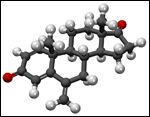SABCS: Updated BOLERO-2 Findings Confirm Efficacy of Everolimus Plus Exemestane
Updated findings from the pivotal phase III Breast Cancer Trials of Oral Everolimus (BOLERO-2) study confirm dramatic improvement in progression-free survival (PFS) in women with metastatic breast cancer when the immunosuppressant agent is combined with the hormonal therapy exemestane.
SAN ANTONIO-Updated findings from the pivotal phase III Breast Cancer Trials of Oral Everolimus (BOLERO-2) study confirm dramatic improvement in progression-free survival (PFS) in women with metastatic breast cancer when the immunosuppressant agent is combined with the hormonal therapy exemestane. Patients who received the everolimus-exemestane combination had a PFS of 7.4 months compared to 3.2 months in those who received exemestane alone, reported lead investigator Gabriel Hortobagyi, MD, professor and chair of the department of breast medical oncology at MD Anderson Cancer Center, Houston (SABCS 2011 abstract S3-7).

Ball-and-stick model of the exemestane (Aromasin) molecule C
20
H
24
O
2
. Source
The randomized, double-blind, placebo-controlled, multicenter trial was conducted at 189 sites worldwide and enrolled 724 postmenopausal women (median age, 62 years) with estrogen receptor (ER)-positive, HER2-negative advanced breast cancer who recurred or progressed while on or following previous treatment with hormonal therapies, letrozole or anastrozole. In a 2:1 ratio, 485 women were randomized to receive the combination of everolimus (10 mg daily) and exemestane, and compared to 239 women who received exemestane and placebo. Preliminary findings were presented in September at the 2011 European Multidisciplinary Cancer Congress in Stockholm, Sweden. "These updated findings represent six months of patient follow-up," Dr. Hortobagyi explained.
Adverse effects, such as shortness of breath, hyperglycemia, mouth sores, and fatigue were all higher in the combination group, but were manageable and did not disrupt the patients' quality of life. Survival data are still being analyzed.
In the earlier analysis, the trial met its primary endpoint of PFS showing treatment with everolimus improved PFS to 6.9 months compared to 2.8 months (hazard ratio, 0.43; 95% confidence interval, 0.35–0.54; P < .0001) by local investigator assessment. Significant improvement was consistent across all subgroups including number of prior therapies, presence of visceral disease, bone metastases, and prior use of chemotherapy.
Although hormonal therapy remains the cornerstone of treatment for women with advanced breast cancer, most women with metastatic disease do not respond to initial treatment and the vast majority of initial responders develop resistance. "Over the years, our treatment approach for such women with metastatic breast cancer has been sequential use of as many hormone therapies as possible, keeping metastatic disease under control for as long as possible," said Dr. Hortobagyi. "These findings may allow us to change our approach."
Everolimus targets mTOR, a protein that targets cancer cells and helps regulate tumor cell division, blood vessel growth, and cell metabolism. Resistance to hormonal therapy in breast cancer has been associated with overactivation of the mTOR pathway. "In this group of heavily treated patients, all of whom progressed on prior endocrine therapy, the addition of this mTOR inhibitor resulted in significant prolongation of PFS and an improved response rate, with only a modest addition of toxicity," he added.
"These are impressive results," commented Dr. Jo Anne Zujewski, head of Breast Cancer Therapeutics in NCI's Division of Cancer Treatment and Diagnosis, who was not involved in the research.
"The benefit is quite remarkable," said Jos Baselga, MD, of Massachusetts General Hospital, who presented the earlier BOLERO-2 findings at the European Multidisciplinary Cancer Congress. The latest results add to a growing list of recent studies of everolimus in breast cancer. Last year at the SABCS researchers presented encouraging results from a trial of everolimus plus tamoxifen for ER-positive, HER2-negative, metastatic disease. And in 2009, Dr. Baselga and colleagues reported that the addition of everolimus to letrozole benefited patients with newly diagnosed ER-positive breast cancer, compared with letrozole alone.
Approximately 220,000 new cases of ER-positive, HER2-negative advanced breast cancer are diagnosed each year.